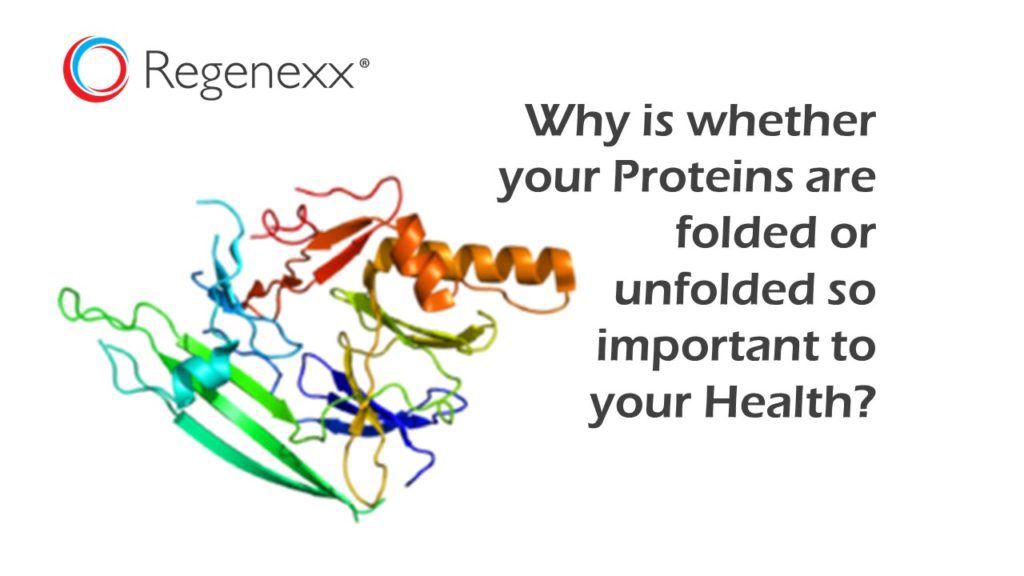What Are Unfolded Proteins, and How Are They Linked to Metabolic Syndrome and Arthritis?

What Are Unfolded Proteins?
To understand unfolded proteins, you first need to understand the mitochondria in the cells. The mitochondria are the battery packs powering each and every cell in the body. Our mitochondria burn out or become less active as we get older, not unlike the batteries in our smartphones for example. When the mitochondria burn out in our stem cells (the body’s “repairmen”), this lessens the body’s ability to repair itself as we age.
How does this happen? The proteins inside of our mitochondrial batteries become “unfolded” over time. Unfolded proteins don’t function optimally, and, unfortunately, as we age, more and more of our proteins become unfolded.
What are folded proteins and why are they so important? The unfolded protein response (UPR) is a mechanism inside the endoplasmic reticulum (ER) in your stem cells, and other cells, whose job it is to fold proteins (or “fix bad proteins”), not unlike a dry cleaner’s folding machine folds shirts. For many proteins to function normally, they need to be folded in a certain way. As we age, we lose more and more power to the UPR folding machinery, resulting in more and more unfolded proteins. Essentially, loads and loads of “bad proteins” that don’t function normally are created.
While science has believed for some time that metabolic syndrome can cause unfolded proteins in stem cells and other cells, a new study suggests the opposite—unfolded proteins may actually cause metabolic syndrome.
What Is Metabolic Syndrome?
Metabolic syndrome is a condition that increases the risk of diseases such as diabetes and heart disease. It’s a collection of issues including obesity and high blood pressure, blood sugar, and triglycerides. Not everyone who has these issues has metabolic syndrome, so there appears to be a heavy genetic influence as well. It typically falls in line with a high-sugar, high-carb (e.g., a lot of bread, pasta, sweets, and sugary drinks) diet; too little exercise; poor sleeping habits; high stress; and more. Many with metabolic syndrome have or are on the way to arthritis and an early death, not necessarily just due to extra weight on the joints but also due to toxic chemicals produced when cartilage breaks down in the joint.
Unfolded Proteins May Result in Metabolic Syndrome
The new study focused on the CNPY2 molecule that lives inside the endoplasmic reticulum inside the cell. The endoplasmic reticulum is a factory where things that the cell needs are made. Mice were created and grown without the CNPY2 molecule. Investigators then induced the unfolded protein response in CNPY2 and non-CNPY2 (control) mice and found that mice with the CNPY2 molecule experienced metabolic stress while the control mice did not. Further experimentation on the mice found that in a high-fat diet, mice with CNPY2 developed liver problems, while those without CNPY2 cells did not experience liver issues. Restoring CNPY2 molecules to the control mice elicited the same metabolic liver issues in the control mice. Researchers concluded that CNPY2 molecules open cellular pathways (termed PERK-CHOP) during the unfolded protein response that create metabolic issues in the liver.
What this all means, in other words, is that all these unfolded proteins may be leading to metabolic syndrome, and targeting CNPY2 molecules in the cell, according to this study, may be one way to treat metabolic syndrome as we age.
Can a Supplement Benefit Our UPR Machine as We Age?
Another way, we’ve recently covered, to keep the UPR machine at optimal performance may be through the supplementation of a natural coenzyme that decreases as we age called NAD+. This natural enzyme in the body nurtures our mitochondria, giving us energy and keeping us healthy and youthful. In a study we recently shared, researchers found they were able to turn the UPR machine power back on in the stem cells of older animals by supplementing with NAD+. The result? More folded proteins and better functioning, younger acting stem cells.
The upshot? I hope you no longer fear unfolded proteins and now understand that as we age, the folding machine in our cells can go awry. This can produce funky proteins that don’t function normally, adding to the aging process, metabolic syndrome, and arthritis. What can you do? The NAD+ supplement may be a good place to start, but it looks like other solutions are also being worked on. In the meantime, eat well, get sleep, exercise, and realize that high-carb meals, like pasta, are for people who run marathons or labor all day in the fields, not for folks who sit at computers!

NOTE: This blog post provides general information to help the reader better understand regenerative medicine, musculoskeletal health, and related subjects. All content provided in this blog, website, or any linked materials, including text, graphics, images, patient profiles, outcomes, and information, are not intended and should not be considered or used as a substitute for medical advice, diagnosis, or treatment. Please always consult with a professional and certified healthcare provider to discuss if a treatment is right for you.
